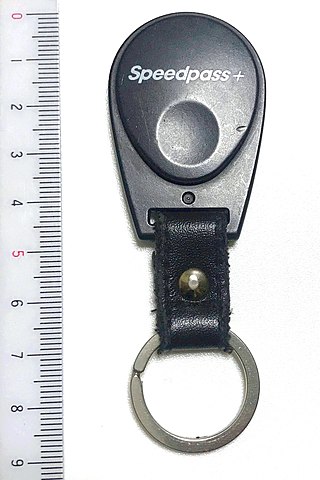Related Research Articles
In cryptography, a block cipher is a deterministic algorithm that operates on fixed-length groups of bits, called blocks. Block ciphers are the elementary building blocks of many cryptographic protocols. They are ubiquitous in the storage and exchange of data, where such data is secured and authenticated via encryption.
In cryptography, key size, key length, or key space refer to the number of bits in a key used by a cryptographic algorithm.

The Data Encryption Standard is a symmetric-key algorithm for the encryption of digital data. Although its short key length of 56 bits makes it too insecure for modern applications, it has been highly influential in the advancement of cryptography.

Symmetric-key algorithms are algorithms for cryptography that use the same cryptographic keys for both the encryption of plaintext and the decryption of ciphertext. The keys may be identical, or there may be a simple transformation to go between the two keys. The keys, in practice, represent a shared secret between two or more parties that can be used to maintain a private information link. The requirement that both parties have access to the secret key is one of the main drawbacks of symmetric-key encryption, in comparison to public-key encryption. However, symmetric-key encryption algorithms are usually better for bulk encryption. With exception of the one-time pad they have a smaller key size, which means less storage space and faster transmission. Due to this, asymmetric-key encryption is often used to exchange the secret key for symmetric-key encryption.

In cryptography, a brute-force attack consists of an attacker submitting many passwords or passphrases with the hope of eventually guessing correctly. The attacker systematically checks all possible passwords and passphrases until the correct one is found. Alternatively, the attacker can attempt to guess the key which is typically created from the password using a key derivation function. This is known as an exhaustive key search.

In cryptography, RC6 is a symmetric key block cipher derived from RC5. It was designed by Ron Rivest, Matt Robshaw, Ray Sidney, and Yiqun Lisa Yin to meet the requirements of the Advanced Encryption Standard (AES) competition. The algorithm was one of the five finalists, and also was submitted to the NESSIE and CRYPTREC projects. It was a proprietary algorithm, patented by RSA Security.
Articles related to cryptography include:
In cryptography, a Feistel cipher is a symmetric structure used in the construction of block ciphers, named after the German-born physicist and cryptographer Horst Feistel, who did pioneering research while working for IBM; it is also commonly known as a Feistel network. A large proportion of block ciphers use the scheme, including the US Data Encryption Standard, the Soviet/Russian GOST and the more recent Blowfish and Twofish ciphers. In a Feistel cipher, encryption and decryption are very similar operations, and both consist of iteratively running a function called a "round function" a fixed number of times.
In cryptography, Lucifer was the name given to several of the earliest civilian block ciphers, developed by Horst Feistel and his colleagues at IBM. Lucifer was a direct precursor to the Data Encryption Standard. One version, alternatively named DTD-1, saw commercial use in the 1970s for electronic banking.
In cryptography, Camellia is a symmetric key block cipher with a block size of 128 bits and key sizes of 128, 192 and 256 bits. It was jointly developed by Mitsubishi Electric and NTT of Japan. The cipher has been approved for use by the ISO/IEC, the European Union's NESSIE project and the Japanese CRYPTREC project. The cipher has security levels and processing abilities comparable to the Advanced Encryption Standard.
In cryptography, Khufu and Khafre are two block ciphers designed by Ralph Merkle in 1989 while working at Xerox's Palo Alto Research Center. Along with Snefru, a cryptographic hash function, the ciphers were named after the Egyptian Pharaohs Khufu, Khafre and Sneferu.

In cryptography, the EFF DES cracker is a machine built by the Electronic Frontier Foundation (EFF) in 1998, to perform a brute force search of the Data Encryption Standard (DES) cipher's key space – that is, to decrypt an encrypted message by trying every possible key. The aim in doing this was to prove that the key size of DES was not sufficient to be secure.
SEED is a block cipher developed by the Korea Information Security Agency (KISA). It is used broadly throughout South Korean industry, but seldom found elsewhere. It gained popularity in Korea because 40-bit encryption was not considered strong enough, so the Korea Information Security Agency developed its own standard. However, this decision has historically limited the competition of web browsers in Korea, as no major SSL libraries or web browsers supported the SEED algorithm, requiring users to use an ActiveX control in Internet Explorer for secure web sites.

Speedpass was a keychain radio-frequency identification (RFID) device introduced in 1997 by Mobil for electronic payment. It was originally developed by Verifone. By 2004, more than seven million people possessed Speedpass tags, which could be used at approximately 10,000 Exxon, Mobil and Esso gas stations worldwide.

VEST (Very Efficient Substitution Transposition) ciphers are a set of families of general-purpose hardware-dedicated ciphers that support single pass authenticated encryption and can operate as collision-resistant hash functions designed by Sean O'Neil, Benjamin Gittins and Howard Landman. VEST cannot be implemented efficiently in software.
In cryptography, key whitening is a technique intended to increase the security of an iterated block cipher. It consists of steps that combine the data with portions of the key.
In cryptography, key stretching techniques are used to make a possibly weak key, typically a password or passphrase, more secure against a brute-force attack by increasing the resources it takes to test each possible key. Passwords or passphrases created by humans are often short or predictable enough to allow password cracking, and key stretching is intended to make such attacks more difficult by complicating a basic step of trying a single password candidate. Key stretching also improves security in some real-world applications where the key length has been constrained, by mimicking a longer key length from the perspective of a brute-force attacker.
KeeLoq is a proprietary hardware-dedicated block cipher that uses a non-linear feedback shift register (NLFSR). The uni-directional command transfer protocol was designed by Frederick Bruwer of Nanoteq (Pty) Ltd., the cryptographic algorithm was created by Gideon Kuhn at the University of Pretoria, and the silicon implementation was by Willem Smit at Nanoteq Pty Ltd in the mid-1980s. KeeLoq was sold to Microchip Technology Inc in 1995 for $10 million. It is used in "code hopping" encoders and decoders such as NTQ105/106/115/125D/129D, HCS101/2XX/3XX/4XX/5XX and MCS31X2. KeeLoq is or was used in many remote keyless entry systems by such companies as Chrysler, Daewoo, Fiat, GM, Honda, Toyota, Volvo, Volkswagen Group, Clifford, Shurlok, and Jaguar.
The following outline is provided as an overview of and topical guide to cryptography:

Speck is a family of lightweight block ciphers publicly released by the National Security Agency (NSA) in June 2013. Speck has been optimized for performance in software implementations, while its sister algorithm, Simon, has been optimized for hardware implementations. Speck is an add–rotate–xor (ARX) cipher.
References
- 1 2 Bono, Stephen C.; Green, Matthew; Stubblefield, Adam; Juels, Ari; Rubin, Aviel D.; Szydlo, Michael (August 2005). "Security Analysis of a Cryptographically-Enabled RFID Device" (PDF). Proceedings of the USENIX Security Symposium.
- 1 2 3 4 5 6 7 8 Wouters, Lennert; Van den Herrewegen, Jan; Garcia, Flavio D.; Oswald, David; Gierlichs, Benedikt; Preneel, Bart (2020). "Dismantling DST80-based Immobiliser Systems". IACR Transactions on Cryptographic Hardware and Embedded Systems. 2020 (2): 99–127. doi:10.13154/tches.v2020.i2.99-127. S2CID 212671625.
- ↑ Kaiser, Ulrich (2008). "Digital Signature Transponder". RFID Security: 177–189. doi:10.1007/978-0-387-76481-8_8. ISBN 978-0-387-76480-1.
- 1 2 Wouters, Lennert; Marin, Eduard; Ashur, Tomer; Gierlichs, Benedikt; Preneel, Bart (2019). "Fast, Furious and Insecure: Passive Keyless Entry and Start Systems in Modern Supercars". IACR Transactions on Cryptographic Hardware and Embedded Systems. 2019 (3): 66–85. doi:10.13154/tches.v2019.i3.66-85. S2CID 173992130.